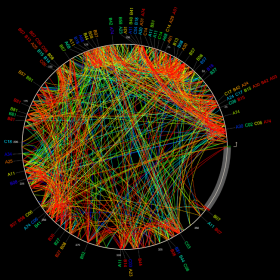HIV-1 Adaptation to NK-Cell-Mediated Immune Pressure
- Galit Alter ,
- David Heckerman ,
- Arne Schneidewind ,
- Lena Fadda ,
- Carl Kadie ,
- Jonathan M. Carlson ,
- Cesar Oniangue-Ndza ,
- Maureen Martin ,
- Bin Li ,
- Salim I. Khakoo ,
- Mary Carrington ,
- Todd M. Allen ,
- Marcus Altfeld
Nature International weekly journal of science | , Vol 476: pp. 96-100

HIV adapts to the innate immune response
 Teaming up with Galit Alter and Marcus Altfeld from the Ragon Institute (opens in new tab), we showed (opens in new tab) that HIV is adapting to the NK-cell-mediated immune response. We used PhyloD to identify HIV polymorphisms that are enriched among patients who express certain KIR genes. These associations imply that HIV is adapting to something specific in these individuals. In fact, NK-cells are activated and in
Teaming up with Galit Alter and Marcus Altfeld from the Ragon Institute (opens in new tab), we showed (opens in new tab) that HIV is adapting to the NK-cell-mediated immune response. We used PhyloD to identify HIV polymorphisms that are enriched among patients who express certain KIR genes. These associations imply that HIV is adapting to something specific in these individuals. In fact, NK-cells are activated and in![]() hibited by their KIR proteins, which bind to HLA-epitope complexes. It looks like HIV mutates to manipulate these interactions, effectively shutting down the Natural Killer cells. What a great example of how we can start from adaptation, then work backward to figure out what’s going on!
hibited by their KIR proteins, which bind to HLA-epitope complexes. It looks like HIV mutates to manipulate these interactions, effectively shutting down the Natural Killer cells. What a great example of how we can start from adaptation, then work backward to figure out what’s going on!
Abstract
Natural killer (NK) cells have an important role in the control of viral infections, recognizing virally infected cells through a variety of activating and inhibitory receptors1, 2, 3. Epidemiological and functional studies have recently suggested that NK cells can also contribute to the control of HIV-1 infection through recognition of virally infected cells by both activating and inhibitory killer immunoglobulin-like receptors (KIRs)4, 5, 6, 7. However, it remains unknown whether NK cells can directly mediate antiviral immune pressure in vivo in humans. Here we describe KIR-associated amino-acid polymorphisms in the HIV-1 sequence of chronically infected individuals, on a population level. We show that these KIR-associated HIV-1 sequence polymorphisms can enhance the binding of inhibitory KIRs to HIV-1-infected CD4+ T cells, and reduce the antiviral activity of KIR-positive NK cells. These data demonstrate that KIR-positive NK cells can place immunological pressure on HIV-1, and that the virus can evade such NK-cell-mediated immune pressure by selecting for sequence polymorphisms, as was previously described for virus-specific T cells and neutralizing antibodies8. NK cells might therefore have a previously underappreciated role in contributing to viral evolution.
